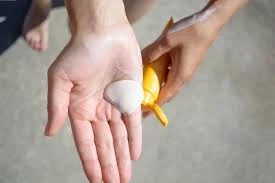The hot sun rays in the summer threaten the skin due to exposure to harmful ultraviolet rays, therefore, it will be necessary to protect the skin in order to enjoy the summer holidays.
One of the most important ways to protect the skin is to use a broad-spectrum sunscreen with a sun protection factor (SPF) of no less than 30, even on cloudy days.
You should apply a large amount of sunscreen, and reapply it to the skin every two hours or more if you are swimming or sweating.
Experts recommend using a generous amount of sunscreen on all exposed skin areas, including the lips, the tips of the ears, the back of the hand, and the neck.
Some sunscreens include an expiration date, which indicates when they are no longer effective.
Experts recommend getting rid of sunscreen that has passed its expiration date.
Most sunscreens remain effective for up to three years after being opened, unless the brand's expiration date states otherwise, according to the Mayo Clinic. However, storage in hot places or exposure to moisture can damage sunscreen components and reduce its effectiveness even before it expires.
Expired sunscreen may be less effective at blocking UV rays, increasing the likelihood of sunburn and increasing the risk of skin cancer. But heavy creams, which generally provide better coverage and sun protection than gels or sprays, can still provide a shield between the skin and the sun, even if the sunscreen has expired.
In addition to sunscreen, avoid midday sun exposure when UV rays are strongest, wear sunglasses that block both types of ultraviolet rays — UVA and UVB — and a wide-brimmed hat and other Protective clothing.
Children are particularly at risk from UV rays because they tend to spend more time outdoors and can get burned easily.
Skin damage caused by the sun increases the risk of the following conditions:
Skin cancer : Skin cancer primarily develops in areas of skin exposed to the sun, including the scalp, face, lips, ears, neck, chest, arms, hands, and legs.
Skin cancer is caused by mutations in the DNA of skin cells. Most damage to DNA in skin cells is caused by ultraviolet rays found in sunlight and in lights used in tanning beds.
- Wrinkles: Although genetics mainly determines the structure and texture of the skin, exposure to sunlight is a major cause of wrinkles, especially for people with fair skin. Exposure to ultraviolet rays leads to the breakdown of the skin's connective tissues, collagen and elastin fibers, located in the deep layer of the skin. Without supportive connective tissue, your skin loses its strength and elasticity. Then the skin begins to sag and wrinkle prematurely.
- Age spots: Age spots result from hyperactivity of melanocytes. Ultraviolet rays accelerate the production of melanin, a natural pigment that gives the skin its color.
On skin that has been exposed to the sun for years, age spots appear when melanin accumulates or is produced in high concentrations. The use of commercial tanning lamps and beds can also cause age spots.






Avoid the midday sun.
ReplyDeleteInformative
ReplyDeleteInformative
ReplyDelete